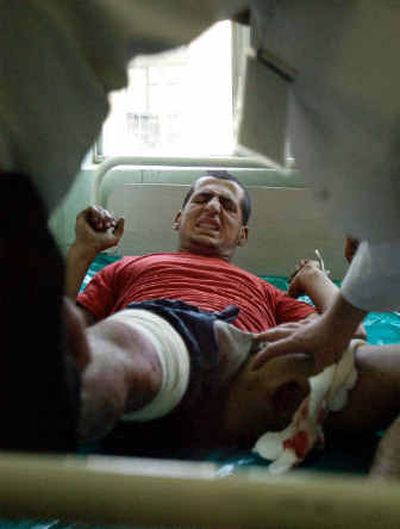Suicide attacks in Iraq increase

BAGHDAD, Iraq – Suicide bombings have become the Iraqi insurgency’s weapon of choice, with a staggering 90 attacks accounting for most of last month’s 750 deaths at the militants’ hands, according to tallies by the U.S. military and news agencies.
Suicide attacks outpaced car bombings almost 2-to-1 in May, according to those tallies. In April, there were 69 suicide attacks – more than in the entire year preceding the June 28, 2004, handover of sovereignty.
The frequency of suicide bombings here is unprecedented, exceeding the practice through years of the Palestinian uprising against Israel and other militant insurgencies such as the Chechen rebellion in Russia. Baghdad alone saw five suicide bombings in a six-hour span Sunday.
With U.S.-led forces now better protected with concrete blast walls and concentric rings of concertina wire and sandbags, the militants have taken to targeting Iraqi police and civilians in their bid to convince Iraqis their new leaders can’t protect them. And increasingly, Iraqis are believed to be carrying out at least some of the suicide attacks.
U.S. officials and Iraqi analysts say that the insurgents’ resources are increasing on several fronts: money to buy cars and explosives, expertise in wiring car and human bombs, and intelligence leaks that help the insurgents target U.S. and Iraqi forces.
Suicide attacks are on the rise because the explosive devices “are simple to construct and easy to operate, thus making suicide bombers difficult to detect,” said Navy Cmdr. Fred Gaghan, in charge of the Combined Explosive Exploitation Cell in Iraq that studies bomb scenes for clues to insurgent tactics.
“At this time, there is nothing to indicate that the availability of volunteers is on the decline,” he said, noting the media coverage and videos of suicide bombings posted on the Internet that fuel extremist recruitment.
Saad Obeidi, a retired Iraqi major general and security expert, suggested that President Bush had invited Islamic extremists to bring their fight against America here.
“One aim of the U.S. military once it invaded Iraq was to lure all insurgents and terrorists from all over the world to confront them here,” he said.
The first suicide bombings of the insurgency were attributed to foreign infiltrators – mostly Palestinians, Yemenis, Syrians and Saudis – but Obeidi believes that has changed.
“The Iraqi way of thinking in the past totally rejected that someone would kill himself,” Obeidi said. “But once they realized how powerful this weapon is and saw its effectiveness, Iraqis started getting involved in suicide operations.”
Some U.S. officials agree.
“There’s a kind of axiom out there that says Iraqis aren’t suicide bombers,” Gen. George W. Casey, commander of multinational forces in Iraq, told reporters in Baghdad this year. “I’m not sure that’s the case. I believe there are Iraqi Islamic extremists … that are very capable of getting into cars and blowing themselves up.”
Other U.S. officials say they still believe that foreign fighters are responsible for most of the suicide attacks, which have increasingly targeted Iraqi civilians and security forces.
“There is no evidence this is being done by Iraqis,” said U.S. Maj. Gen. John Defreitas, intelligence chief for the multinational mission that has 150,000 troops in Iraq. “In every case we’ve seen, the driver has been a foreigner.”
Coalition officials acknowledge, however, that the numbers show an Iraqi-dominated insurgency. Fewer than 5 percent of those killed or captured have been foreigners, one official noted. He also described the influx from abroad as a “very, very small part” of the estimated 12,000 to 20,000 insurgents.